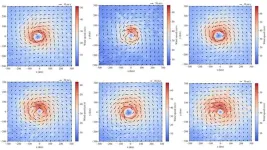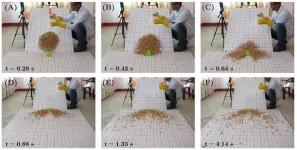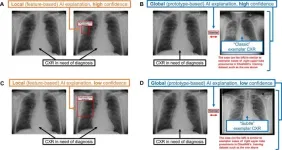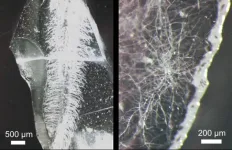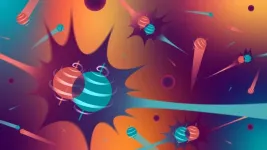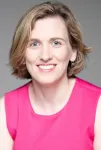(Press-News.org) A dog learns to sit on command, a person hears and eventually tunes out the hum of a washing machine while reading … The capacity to learn and adapt is central to evolution and, indeed, survival.
Habituation — adaptation’s less-glamorous sibling — involves the lessening response to a stimulus after repeated exposure. Think the need for a third espresso to maintain the same level of concentration you once achieved with a single shot.
Up until recently, habituation — a simple form of learning — was deemed the exclusive domain of complex organisms with brains and nervous systems, such as worms, insects, birds, and mammals.
But a new study, published Nov. 19 in Current Biology, offers compelling evidence that even tiny single-cell creatures such as ciliates and amoebae, as well as the cells in our own bodies, could exhibit habituation akin to that seen in more complex organisms with brains.
The work, led by scientists at Harvard Medical School and the Centre for Genomic Regulation (CRG) in Barcelona, suggests that single cells are capable of behaviors more complex than currently appreciated.
“This finding opens up an exciting new mystery for us: How do cells without brains manage something so complex?” said study senior author Jeremy Gunawardena, associate professor of systems biology in the Blavatnik Institute at HMS. He co-led the study with Rosa Martinez Corral, a former post-doctoral researcher in his lab who now leads a research group in systems and synthetic biology at CRG.
The results add to a small but growing body of work on this subject. Earlier work led by Gunawardena found that a single-cell ciliate showed avoidance behavior, not unlike the actions observed in animals that encounter unpleasant stimuli.
In this video, a single-cell pond dweller called Stentor roeselii exhibits markers of avoidance behavior, as reported in earlier research led by Gunawardena. The new study suggests this organism is also capable of habituation.
What the researchers discovered
Instead of studying cells in a lab dish, the scientists used advanced computer modeling to analyze how molecular networks inside ciliate and mammalian cells respond to different patterns of stimulation. They found four networks that exhibit hallmarks of habituation present in animal brains.
These networks shared a common feature: Each molecular network had two forms of “memory” storage that captured information learned from the environment. One memory decayed much faster than the other — a form of memory loss necessary for habituation, the researchers noted. This finding suggests that single cells process and remember information over different time spans.
Implications
Studying habituation in single cells could help propel understanding of how learning in general works, the researchers said. The findings also cast the humble single-cell creatures in a new, more tantalizing light: They are not merely molecular machines packed in microscopic bodies, but they are also agents that can learn.
But what about more practical applications?
The researchers caution that these remain purely speculative for now. Yet one daring idea would be to apply the concept of habituation to the relationship between cancer and immunity.
Tumors are notoriously good evaders of immune surveillance because they trick immune cells into viewing them as innocent bystanders. In other words, the immune cells responsible for recognizing cancer may get somehow habituated to the presence of a cancer cell — the immune cell gets used to the stimulus and no longer responds to it.
“It’s akin to delusion. If we knew how these false perceptions get encoded in immune cells, we may be able to re-engineer them so that immune cells begin to perceive their environments correctly, the tumor becomes visible as malign, and they get to work,” Gunawardena said.
“It is a fantasy right now, but it is a direction I would love to explore down the road.”
Authorship, funding, disclosures
Additional authors included Lina Eckert, Maria Sol Vidal-Saez, Ziyuan Zhao, and Jordi Garcia-Ojalvo.
The research was supported by a doctoral fellowship 2021-FI-B-00408 from the Agència de Gestió d’Ajuts Universitaris i de Recerca from the Generalitat de Catalunya; a Harvard University Program for Research in Science and Engineering Award; the Spanish State Research Agency and FEDER Project PID2021-127311NB-I00; Spanish Ministry of Science and Innovation and the Generalitat de Catalunya; EMBO Fellowship ALTF683–2019, RYC2021-033860-I funded by MCIN/AEI/10.13039/501100011033 and by European Union NextGenerationEU/PRTR; with additional support from the Spanish Ministry of Science and
Innovation through the Centro de Excelencia Severo Ochoa (CEX2020-001049-S, MCIN/AEI/10.13039/ 501100011033) and the Generalitat de Catalunya through the CERCA programme; and with funding from AFOSR Grant FA9550-22-1-0345.
END
How cells get used to the familiar
Research reveals even single-cell organisms exhibit habituation, a simple form of learning
2024-11-19
ELSE PRESS RELEASES FROM THIS DATE:
Seemingly “broken” genes in coronaviruses may be essential for viral survival
2024-11-19
Viruses are lean, mean, infection machines. Their genomes are tiny, usually limited to a handful of absolutely essential genes, and they shed extra genomic deadweight extremely fast.
Usually.
Coronaviruses, including SARS-CoV-2 (the virus that causes COVID-19), appear at first glance to be an exception. They have some extra “accessory” genes in addition to the usual minimal viral set, and scientists don’t know what most of them do. Scientists believe these extra genes must be doing something important, though, or they would be rapidly lost as the viruses evolved.
Now, University of Utah Health researchers have found that some of these viral genes have stuck around ...
Improving hurricane modeling with physics-informed machine learning
2024-11-19
WASHINGTON, Nov. 19, 2024 – Hurricanes, or tropical cyclones, can be devastating natural disasters, leveling entire cities and claiming hundreds or thousands of lives. A key aspect of their destructive potential is their unpredictability. Hurricanes are complex weather phenomena, and how strong one will be or where it will make landfall is difficult to estimate.
In a paper published this week in Physics of Fluids, by AIP Publishing, a pair of researchers from the City University of Hong Kong employed machine learning to more accurately model the boundary layer wind field of tropical cyclones.
In atmospheric science, the boundary layer ...
Seed slippage: Champati cha-cha
2024-11-19
WASHINGTON, Nov 19, 2024 – Champatis, the seeds of the Lapsi tree, are valued in Nepal for their medical, economic, social, and cultural significance. They are also popular among children as simple playthings. But for a group of physicists, these unique seeds—and the way they bounce and roll down slopes—could help them better understand landslides and avalanches, leading to research that could save lives.
In a study published this week in Physics of Fluids, by AIP Publishing, a team ...
Hospitalization following outpatient diagnosis of RSV in adults
2024-11-19
About The Study: In this cohort study of adults with outpatient medically attended-respiratory syncytial virus (RSV) infections from 3 large deidentified U.S. databases across 6 RSV seasons, approximately 1 in 20 adults experienced all-cause hospitalization within 28 days. The results of this study highlight the public health need for RSV prevention and treatment.
Corresponding Author: To contact the corresponding author, Joshua T. Swan, PharmD, MPH, email swan.joshua@gmail.com.
To access the embargoed study: Visit our For The Media ...
Beyond backlash: how feeling threatened by diversity can trigger positive change
2024-11-19
In recent years, employers across North America have introduced or boosted equity, diversity and inclusion (EDI) programs in hopes of creating a more diverse and inclusive workplace culture.
But studies have shown that fostering diversity can come with a steep cost, as employees from dominant groups often felt threatened, leading to a backlash against the very groups the employers are seeking to support.
But could those feelings of threat also lead to learning and change, and eventually allyship? ...
Climate change exposure associated with increased emergency imaging
2024-11-19
OAK BROOK, Ill. – Using data collected over a 10-year period from four emergency departments, researchers at the University of Toronto found that short-term exposure to ambient heat and air pollution levels was associated with increased utilization of X-rays and computed tomography (CT). Results of the study were published today in Radiology, a journal of the Radiological Society of North America (RSNA).
“Extreme climate exposures are associated with higher demand for health care including emergency department visits,” ...
Incorrect AI advice influences diagnostic decisions
2024-11-19
OAK BROOK, Ill. – When making diagnostic decisions, radiologists and other physicians may rely too much on artificial intelligence (AI) when it points out a specific area of interest in an X-ray, according to a study published today in Radiology, a journal of the Radiological Society of North America (RSNA).
“As of 2022, 190 radiology AI software programs were approved by the U.S. Food and Drug Administration,” said one of the study’s senior authors, Paul H. Yi, M.D., director of intelligent imaging informatics and associate member in ...
Building roots in glass, a bio-inspired approach to creating 3D microvascular networks using plants and fungi
2024-11-19
Fukuoka, Japan— Microfluidic technology has become increasingly important in many scientific fields such as regenerative medicine, microelectronics, and environmental science. However, conventional microfabrication techniques face limitations in scale and in the construction of complex networks. These hurdles are compounded when it comes to building more intricate 3D microfluidic networks.
Now, researchers from Kyushu University have developed a new and convenient technique for building such complex 3D microfluidic networks. Their tool? Plants and fungi. The team developed a ‘soil’ medium using nanoparticles of glass (silica) and a cellulose ...
Spinning fusion fuel for efficiency
2024-11-19
A different mix of fuels with enhanced properties could overcome some of the major barriers to making fusion a more practical energy source, according to a new study.
The proposed approach would still use deuterium and tritium, which are generally accepted as the most promising pair of fuels for fusion energy production. However, the quantum properties of the fuel would be adjusted for peak efficiency using an existing process known as spin polarization. In addition to spin polarizing half the fuels, the percentage of deuterium would be increased from the usual amount of roughly 60% or more.
Models created by scientists at the U.S. Department ...
The American Pediatric Society names Dr. Beth Tarini as the recipient of the 2025 Norman J. Siegel New Member Outstanding Science Award
2024-11-19
The American Pediatric Society (APS) is pleased to announce Beth A. Tarini, MD, MS, MBA, as the 2025 Norman J. Siegel New Member Outstanding Science Award recipient for her considerable contributions to pediatric science. The award will be presented to Dr. Tarini during the APS Presidential Plenary at the Pediatric Academic Societies 2025 Meeting in Honolulu, Hawaii, April 24 – April 28.
The award was created in honor of one of the world’s leading nephrologists, Norman J. Siegel, MD, FASN. Dr. Siegel was an outstanding ...
LAST 30 PRESS RELEASES:
SIMJ announces global collaborative book project in commemoration of its 75th anniversary
Air pollution exposure and birth weight
Obstructive sleep apnea risk and mental health conditions among older adults
How talking slows eye movements behind the wheel
The Ceramic Society of Japan’s Oxoate Ceramics Research Association launches new international book project
Heart-brain connection: international study reveals the role of the vagus nerve in keeping the heart young
Researchers identify Rb1 as a predictive biomarker for a new therapeutic strategy in some breast cancers
Survey reveals ethical gaps slowing AI adoption in pediatric surgery
Stimulant ADHD medications work differently than thought
AI overestimates how smart people are, according to HSE economists
HSE researchers create genome-wide map of quadruplexes
Scientists boost cell "powerhouses" to burn more calories
Automatic label checking: The missing step in making reliable medical AI
Low daily alcohol intake linked to 50% heightened mouth cancer risk in India
American Meteorological Society announces Rick Spinrad as 2026 President-Elect
Biomass-based carbon capture spotlighted in newly released global climate webinar recording
Illuminating invisible nano pollutants: advanced bioimaging tracks the full journey of emerging nanoscale contaminants in living systems
How does age affect recovery from spinal cord injury?
Novel AI tool offers prognosis for patients with head and neck cancer
Fathers’ microplastic exposure tied to their children’s metabolic problems
Research validates laboratory model for studying high-grade serous ovarian cancer
SIR 2026 delivers transformative breakthroughs in minimally invasive medicine to improve patient care
Stem Cell Reports most downloaded papers of 2025 highlight the breadth and impact of stem cell research
Oxford-led study estimates NHS spends around 3% of its primary and secondary care budget on the health impacts of heat and cold in England
A researcher’s long quest leads to a smart composite breakthrough
Urban wild bees act as “microbial sensors” of city health.
New study finds where you live affects recovery after a hip fracture
Forecasting the impact of fully automated vehicle adoption on US road traffic injuries
Alcohol-related hospitalizations from 2016 to 2022
Semaglutide and hospitalizations in patients with obesity and established cardiovascular disease
[Press-News.org] How cells get used to the familiarResearch reveals even single-cell organisms exhibit habituation, a simple form of learning

